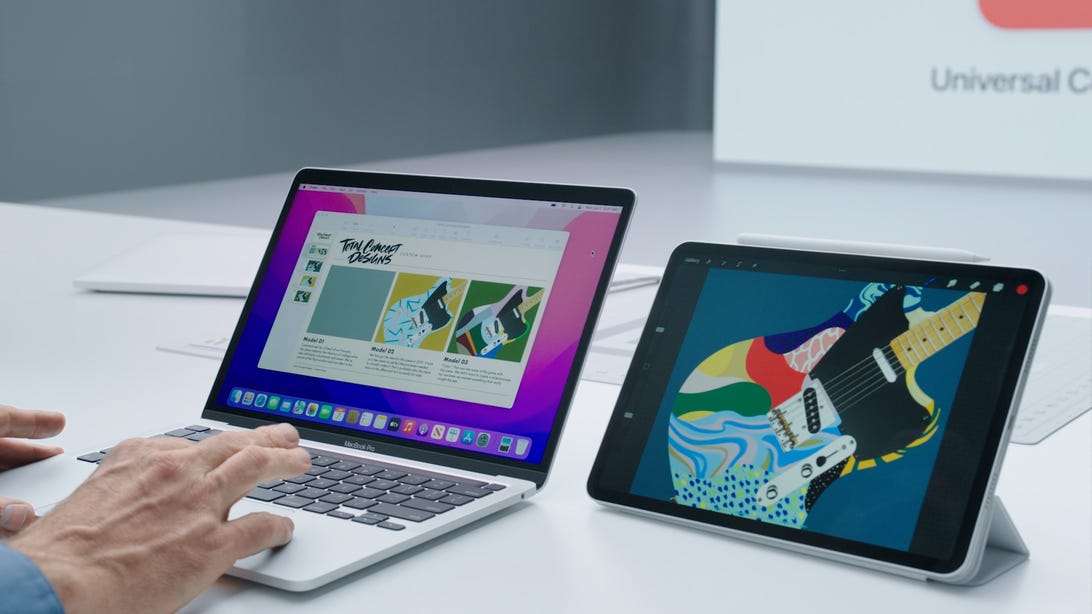
Universal Control is here now, and it works about as well as I had hoped.
Screenshot/AppleI've wanted iPads and Macs to fuse for years. They're still separate in 2022. But a common thread runs through both: Literally, it's the cursor that jumps between my iPad and MacBook on my desk right now.
Apple's Universal Control, a much-anticipated feature that's live as a beta in iPadOS 15.4 and MacOS 12.3, is uncanny at times, invisible at others. And sometimes it doesn't work at all.
The feature allows a Mac keyboard and trackpad/mouse to also control a nearby iPad -- or vice versa, if you're using an iPad keyboard or accessory. Basically, it allows any nearby keyboard, seemingly, to control all devices. Hence, Universal Control. I've tried it on a 12-inch iPad Pro and the latest iPad Air so far, alongside an M1 MacBook Air.
The idea isn't that wild in concept, but trying it out does feel like the most magical thing I've seen in recent versions of iPadOS. My MacBook cursor, when approaching the edge of my display, just leaps off and enters the iPad. Yes, just like you can do with any other connected secondary monitor.
What makes it uncanny is that iPadOS runs differently. Over in iPad-Land, the cursor becomes larger and morphs into the apps it hovers near. It mimics how trackpads and keyboards and mice already work on iPadOS.
Before this, Apple already had Sidecar, which also let iPads act as Pencil-compatible second screens for Macs. Universal Control feels like another step. And weirdly, of all things this relationship reminds me of right now, it makes me think of VR… and what Meta has been doing with its Quest headsets and computers.
Meta's own Horizon Workrooms app, and a handful of other apps, can pair with a MacBook or a few other keyboards to make it feel like your device has suddenly leapt into your VR headset. In Horizon Workrooms, a computer can control VR. Or, your VR headset can interface with your computer desktop and become a head-worn second screen.
With all of Apple's expected visions of AR, including a reported headset sometime in the next year, being able to remotely access and dovetail devices will be critical. In fact, cross-device relationships are at the heart of what the current metaverse hype cycle is all about. But, even if you don't ever wear an Apple VR/AR headset, expanding the ways that iPhones, iPads, Macs and Apple TVs feel like interlinked nodes of one ambient super-device seems like the way forward. Not just for Apple, but for tech in general.
Universal, but not always intuitive
Universal Control isn't intuitive to set up, though. It doesn't "just work" when you update your OS. Instead, you need to make sure both devices have Bluetooth on, are on the same Wi-Fi network, are near each other and have some particular settings toggled on. For the Mac, in Display settings, Universal Control has three particular settings that need to be checked off, all listed as "beta" features, allowing the Mac to have its cursor/keyboard extend, push through the edge of the display and reconnect to a nearby device. You can add the iPad as a display after that, and rearrange the two displays like any set of monitors with a Mac. The iPad needs to have "cursor and keyboard (beta)" enabled in the Airplay and Handoff part of settings, too.
After that, it seems to work, but sometimes I find when I wake devices up from sleep they don't automatically seem to activate. I'm still getting used to it. Also, it's a beta feature. And while the MacBook Air's trackpad seems to work fine on the iPad Pro, the iPad Pro's Magic Keyboard trackpad seems to track slowly on the Mac.
But, is it fun to leap across both devices with one keyboard and trackpad? Yes, yes it is. And sometimes, controlling the iPad or Mac from the other device, it feels like mind-reading. Or remote telepresence. And with a monitor connected to the MacBook Air, plus the iPad nearby, it's now a three-screen system of sorts that I control with one keyboard/trackpad.
I still think iPadOS should evolve into MacOS or add a Mac layer, especially for pro-level iPads. Macs are overdue for some touchscreen experiences, too. While Universal Control doesn't do that, it makes the devices feel so much more connected. I can even bring some things across the divide: A file can be dragged across from my Mac desktop, but it needs to land in a particular app to finish transferring (like Apple's iPadOS Files app). Yet, I can't drag windows or apps or browser tabs with me, though, like I always do on monitors with the Mac. So close, and yet so far.
iPads still don't extend to other monitors except with a few apps. But what if they did? And what if iPads ran an OS ecosystem similar to Macs? Complete the journey, Apple, and revamp iPadOS at WWDC this year. The pieces are all there. The job just needs to be finished. Let these worlds merge, because the walls are already growing thinner than ever.
Article From & Read More ( Universal Control From Apple Deepens the iOS-MacOS Relationship - CNET )https://ift.tt/LtBX9cD
Technology

No comments:
Post a Comment